Nicholas Kinsey's Blog, page 5
February 18, 2018
20 – SHIPWRECKED LIVES
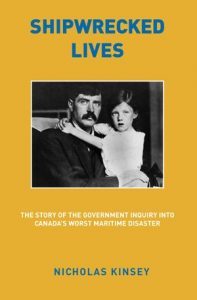 This week we are talking about my third novel “Shipwrecked Lives” (290 pages) which is in various stages of rewriting and should be out in a few months. “Shipwrecked Lives” tells the story of the government inquiry into the sinking of the Empress of Ireland in 1914. The ship sank in 14 minutes and claimed the lives of 1012 people.
This week we are talking about my third novel “Shipwrecked Lives” (290 pages) which is in various stages of rewriting and should be out in a few months. “Shipwrecked Lives” tells the story of the government inquiry into the sinking of the Empress of Ireland in 1914. The ship sank in 14 minutes and claimed the lives of 1012 people.
The book was edited last summer and I recently completed rewrite no. 10. I have sent the manuscript to readers of mine and I am also checking the various navigational theories with regards to the two ships.
There is a wonderful book entitled “Forgotten Empress” by David Zeni which gives a lot of information about the ship and the inquiry. Last year I learned the following lines:
“On June 2 (1914) a foreign national was found wandering along the shore between Father Point and Rimouski. The foreigner was a woman believed to be a passenger from the Empress. The woman may have been travelling to Sweden and was found “naked in a daze”. Newspapers said she had been driven insane by the tragedy.”
Well, this poor woman “naked on the beach” is now one of the main characters in “Shipwrecked Lives”. Her name is Alice Bingham and she lost her husband and child in the collision. Alice managed to survive by floating on a wooden crate and was washed ashore.
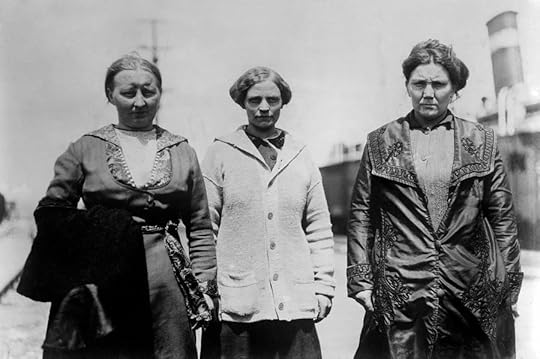 Empress of Ireland survivors
Empress of Ireland survivorsThe foreign woman was not alone. Among the bodies washed ashore, there was a young girl discovered by thirteen-year-old Eileen Tuggy. The local people built a coffin and sent the body to Quebec City for identification. When the coffin was opened on Pier 27, a wreath of lilies was found resting on the body with a note from Eileen which read: “Kindly accept my kindest and sincerest sympathy. May she rest in peace. If identified, I would like to know.”
The story of the Empress is full of heart-wrenching tales. A thousand men, women and children drowned that night in the fog on the St. Lawrence River. Many of the passengers were first generation Canadians on their way back to the old country for a visit. Their deaths provoked long periods of unhappiness and changed the course of their children’s lives.
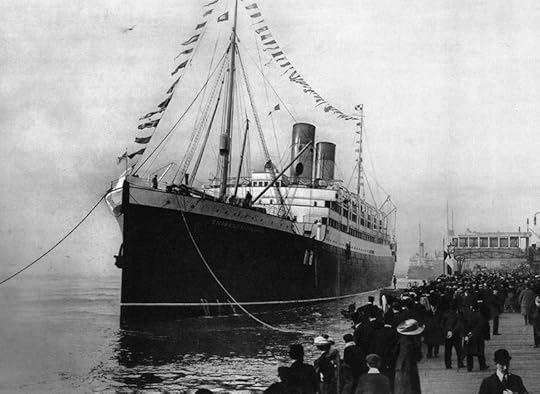 Empress of Ireland
Empress of IrelandOther news:
Some further news. I am planning a virtual book tour for “An Absolute Secret” starting in March and April, and I have been invited to the Chateau Frontenac to give a conference during the 75th anniversary of the 1943 Quebec Conference.
My first novel “Playing Rudolf Hess” is going to Kindle Select for a 90-day promotion including one week where it will be offered free of charge. So everyone who hasn’t read it, please take note.
And with this I wish you all a very pleasant week.
December 11, 2017
19 – AN ABSOLUTE SECRET
An Absolute Secret is out in paperback and in four different ebook formats. You can buy it for as little as $5 as an ebook and get it immediately, or lay out some $22 for the paperback. The novel is an exciting spy thriller set in wartime Sweden that you won’t be able to put down. So don’t hesitate to put in your order. And if you buy it, write a review. All help is appreciated.
Perhaps the most interesting scene in my book is the meeting between Peter Faye (real name Falk) and Anthony Blunt at the Reform Club in London in December 1943. Blunt worked for MI5 during the war years and it was only later revealed that he was a Soviet spy, part of the famous “Cambridge Five” including Philby, McLean, Burgess, Cairncross and Blunt.
Faye had been summoned to London by MI5 to discuss the secret documents from the Karl-Heinz Kramer operation in Stockholm in September of the same year. Kramer was German spy working for the Abwehr who drove around Stockholm in a white DKW convertible and called himself Himmler’s personal representative. Faye had run a very successful operation using an Austrian maid in the Kramer household to remove secret documents from Kramer’s study and to photograph them, before sending them on their way to London where they created quite a stir within the intelligence services. The very first document that was removed from Kramer’s study was the secret memorandum of conversations between Roosevelt and Churchill at the August 1943 Quebec Conference.
Imagine the desolate atmosphere of London in the winter of 1943. The war was still going strong and London was devastated by the bombing. The elegant Reform Club on Pall Mall was still standing although a large swath of buildings in the area had been bombed. In a private room Blunt advanced the idea that the secret memorandum of the conversation between Roosevelt and Churchill was a German forgery. He proposed that the wording was Germanic in its formulation, but Faye was having none of it. He had been present at the 1941 Atlantic Conference in Placentia Bay, Newfoundland and had been shocked by Roosevelt’s vulgarity along with a large number of British staff. In his mind no one could mimic Roosevelt’s obscene remarks about Stalin and certainly a German intelligence officer couldn’t produce a conversation with this level of vulgarity. Clearly Blunt was trying to minimise the importance of the stolen documents and may have been involved in seeing them leaked to Moscow in the first place.
It is hard to imagine a scene more incongruous when we know about Blunt’s commitment to Moscow and the fact that he may also have been involved in leaking the document himself. The memorandum had probably been sent first to the Soviet KGB or GRU, and then a double agent working for a foreign government had copied it on to the Japanese spymaster General Onodera in Stockholm who then sold it to Karl-Heinz Kramer.
This is just one of a number of amazing scenes in my novel, most of which are based on known facts as related by witnesses. The details concerning the purloined documents from Kramer’s house were revealed by Peter Falk in an unpublished manuscript and reported by Hugh Thomas in his book: “The Strange Death of Heinrich Himmler” (2002). My novel tells the story of the British surveillance of Dr Kramer, the ‘White Buses’ operation organized by Count Folke Bernardotte to save the Scandinavian prisoners of German concentration camps, the secret negotiations between SSBrigadeführer Walter Schellenberg and the Swedish, British and American governments during the war.
Let me know what you think about the novel and its underlying historical context in the comments below.
You can buy the novel in your prefered format using the links below.
Available now in paperback or ebook from
[Barnes and Noble]
[Amazon]
[Kobo] [iBook]
And Giveaway from Goodreads until December 31st, 2017
November 20, 2017
18 – AN ABSOLUTE SECRET ON AMAZON
An Absolute Secret is out in paperback on Amazon. For some reason it costs $44 in Canada and $19 in the US. I am expecting Amazon to correct this shortly. The ebooks will be available in the first week of December. Meanwhile we are going ahead with a special promotion on KDP Selection (Kindle on Amazon) for Playing Rudolf Hess which will be exclusive to Kindle for 90 days and linked to An Absolute Secret.
I will be doing a special Canadian promotion of AAS at various venues in Quebec (Morrin Centre, etc.) in December and January. Here is the scoop on our headline story:
THE SECRETS OF THE QUEBEC CONFERENCE LEAKED TO A GERMAN SPY
Did you know that the secret memorandum of the first Quebec Conference between Churchill, Roosevelt and King, which took place in Quebec City from Aug. 17- 24, 1943, was leaked to a German spy within a few weeks of the event?
In his new novel “An Absolute Secret” (Booklocker, 373 pages), filmmaker and novelist Nicholas Kinsey (Playing Rudolf Hess) of Quebec City tells the story of how a British intelligence officer in Stockholm discovered the rough drafts and secret memoranda from the private discussions of Roosevelt and Churchill within weeks of the event. Who leaked the documents? How did they get into the hands of a German spy in Stockholm?
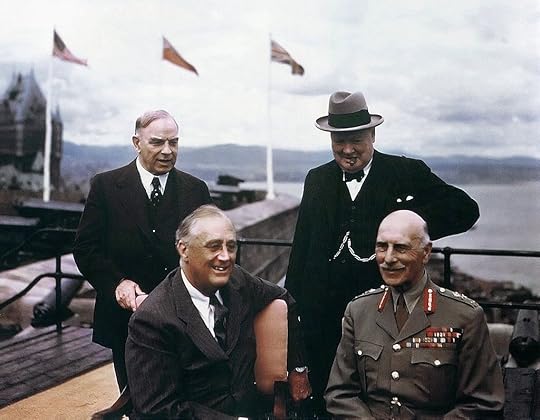 Mackenzie King, Franklin D. Roosevelt, Winston Churchill, and the Earl of Athlone at La Citadelle
Mackenzie King, Franklin D. Roosevelt, Winston Churchill, and the Earl of Athlone at La CitadelleWe expect the national news media to pick up the story about this fascinating historical anomaly.
The year is coming to an end. It’s been a very busy year for me as a writer, painter, teacher and videographer. Yes, I work a 40-hour week to make a living just like the average working stiff. In my case it is a mix of house painting, ESL teaching, shooting video and film production. In between, that is evenings and weekends I get to write novels.
Next time we will talk about my upcoming novel Shipwrecked Lives and Remembrance Man, my third and fourth novels respectively which will be out next year.
And with this I wish you all a very pleasant week.
October 24, 2017
17 – CANADIANS LOVE PBS
Canadians love PBS and, for reason, the public network is an extraordinary success story in the bleak world of headline news. PBS broadcast recently Ken Burn’s and Lynn Novick’s extraordinary new series “The Vietnam War”, a 10 part, 18-hour television documentary series with a budget of some $30 million.
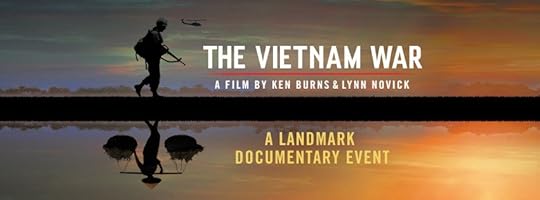
Many of you may have watched a few episodes of this wonderful series. I loved the interviews with the ordinary marines and their take on the war. They knew as far back as 1963/64 that the war was not winnable. I also loved the interviews with the Croker family from Saratoga Springs (a short ride south of Montreal) and their story of a son who wanted to go to Vietnam and eventually was killed there. Every American voter and school-age kid should see this series. It shows just how stupid the politicians were at the time and still are.
PBS presents more American culture than any other network in the US. Just look at any episode of the PBS Newshour with its politics, business and economic issues, music, books, and even poetry readings. We have nothing in Canada that even comes close to matching the cultural breadth of PBS and it is unfortunate because we invest twice as much in a rather poorly managed national network called the CBC.
Wouldn’t it be lovely in Canada if we had a documentary program like American Experience. We could call it Canadian Experience and show historical documentaries about Canada’s rich and generally ignored history.
On our 150th anniversary our national broadcaster offered us an idiotic, self-promoting pablum called “Canada: a history of us” which was a public relations disaster when it was broadcast in the spring. Clearly, the CBC doesn’t do history or culture very well.
PBS has a cultural mandate and values historical documentaries and drama, operating across 50 states around the country. Canadians love their programming: Frontline, Nova, Nature, American Masters, Independent Lens, Masterpiece Theatre, and of course, the Newshour. We even contribute financially to numerous PBS border stations and NPR. The operating budget of PBS and NPR is only about half that of the CBC’s, but they still manage to provide first class programming for a sophisticated class of viewers.
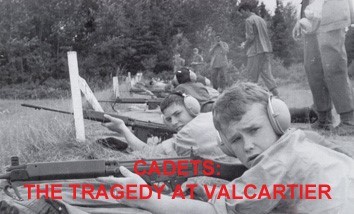
I mentioned last time I would tell you about my movie project, ‘Cadets: the Tragedy at Valcartier’, which tells the story of the 1974 tragedy that killed six cadets when a grenade exploded during a training session.
Six teenage boys died and fifty-four were injured in the explosion of a live grenade during a lecture on explosives safety. A live grenade had inadvertently made its way into a box of dud ammunition. One hundred and forty boys survived, each isolated in their trauma, yet expected to carry on with their lives. The young cadets were basically abandoned by their officers who told them not to talk about the event. They were later interrogated aggressively by senior officers in a secret location in the hope of finding a scapegoat. No psychological help was provided to help the cadets with the emotional burden of those terrible days and the senior commanders did their best to ignore this devastating incident.
I wrote the screenplay in 2016 and rewrote it this summer. It is a shocking story of incompetence and heartlessness in the Canadian military and could do very well at the box office. I am hoping to go into production in 2018 if I can bring the financing together.
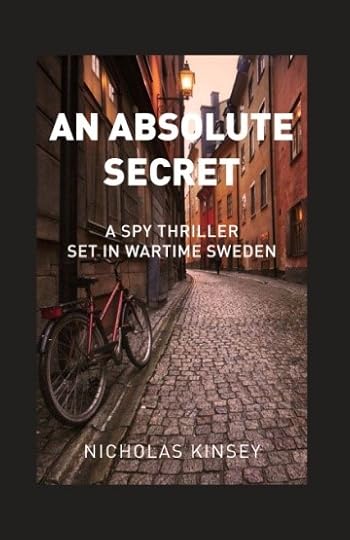
Some good news! My second novel, An Absolute Secret (373 pages), is at the publishers and the first copies of the paperback will be out in a week or two. It should be available as an ebook by the end of the month.
And with this I wish you all a very pleasant week.
September 10, 2017
16 – WHY I TELL THE STORIES I DO
I find stories hidden in history books. These often describe events that are so remarkable that they jump right out at you. You immediately feel that these stories are begging to be told in more detail. You want to know more about the characters and the events, and you know that the public will have the same reaction as you do. So often I don’t have to invent very much to write a novel based on historical events.
Over the summer I have had discussions with a film distributor for my upcoming feature movie “Cadets” about the Valcartier explosion which killed six young cadets in 1974 at the Valcartier military base north of Quebec City. I optioned the book by Gerry Fostaty “As you were, the Tragedy at Valcartier” back in 2015 and wrote a script that I thought was quite effective in telling the real story behind the catastrophe.
Of course, script writers are always under pressure to deliver the perfect script by people who know little or nothing about writing scripts. We are questioned by producers, investors, and dealmakers who have little or no knowledge about the art of filmmaking. Some of these people prefer to see as much historical accuracy as possible on the screen while others want to bend the truth and completely change the course of events.
I have always taken the position that if you are going to tell the true story of an event, you must stick to the facts as much as possible and only invent when there are no facts to guide one. Of course, most movies based on real events need some fictional elements to provoke the viewer or give them an edge. We are not making documentaries. This can be quite difficult to do and at the same time to respect the original story.
 Some of you may remember Argo about the American hostages who were hidden at the Canadian Embassy in Tehran in 1979 during the Iranian revolution. The 2012 movie starred and was directed by Ben Affleck who later won an Academy Award for Best Picture. In reality Argo was a totally fictional movie masquerading at a true story. There were so many historical inaccuracies in the movie that even the ex-President Jimmy Carter weighed in against it. Here is what he said on CNN:
Some of you may remember Argo about the American hostages who were hidden at the Canadian Embassy in Tehran in 1979 during the Iranian revolution. The 2012 movie starred and was directed by Ben Affleck who later won an Academy Award for Best Picture. In reality Argo was a totally fictional movie masquerading at a true story. There were so many historical inaccuracies in the movie that even the ex-President Jimmy Carter weighed in against it. Here is what he said on CNN:
“90% of the contributions to the ideas and the consummation of the plan was Canadian. And the movie gives almost full credit to the American CIA. And with that exception, the movie is very good. But Ben Affleck’s character in the film was… only in Tehran a day and a half. And the main hero, in my opinion, was Ken Taylor, who was the Canadian ambassador who orchestrated the entire process.”
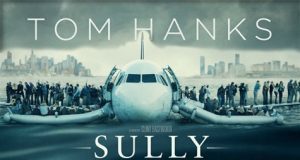 I don’t know many writers who would accept to write such a total distortion of the facts. You’ve got to be a real hack writer to prostitute yourself in this way. The same goes for the recent Sully movie directed by Clint Eastwood about landing the plane on the Hudson river by Captain “Sully” Sullenberger which came out in 2016. Again this is another film that received harsh criticism. The Guardian newspaper calling it a “pious hagiopic that even Tom Hanks can’t save”.
I don’t know many writers who would accept to write such a total distortion of the facts. You’ve got to be a real hack writer to prostitute yourself in this way. The same goes for the recent Sully movie directed by Clint Eastwood about landing the plane on the Hudson river by Captain “Sully” Sullenberger which came out in 2016. Again this is another film that received harsh criticism. The Guardian newspaper calling it a “pious hagiopic that even Tom Hanks can’t save”.
The main concern with this movie is that the antagonistic relationship between Sully and the National Transportation Safety Board was a complete fabrication. Eastwood claimed he couldn’t make the movie without a villain in the piece and there were no villains. So the writers invented a villain, the NTSB. Poor Sully becomes a cash-strapped pilot – he fears his house will be taken away from him and he will lose his pension. He will be judged by the bad guys at the NTSB on his last 208 seconds in the air.
Here’s another Hollywood movie that is a complete invention where the writers twist the facts any which way they can. I am bringing this up because my film distributor told me to take a look at the Sully movie as an example of how to make an excellent movie based on a true story.
Well, I did take a look at the picture and, what really pissed me off, happened in the first few seconds of the movie. If you saw the movie, you will remember the use of a dream sequence in the teaser where a plane is flying through the skyline of NYC just like the hijacked planes in September 2001. Here we are telling a story about an airliner that lands on the Hudson and we show a 9/11 style clip in order to get public attention. Is Sully’s plane going to crash into a skyscraper and explode in a burst of flames? It would have been equally manipulative to have Sully about to crash his car. The idea is to put the spectator on the edge of his or her seat during the teaser. Well, they’ve done it alright but it’s an outrageous and highly manipulative use of images that have nothing to do with the Hudson landing.
Isn’t there a better script out there for the Sully movie, one with a more reflective feel? I think there is. Not everything can be boiled down to good vs evil even in cinema. The cheap manipulation and the choice of villain make this a very bad movie, but it seems to be that the public doesn’t care really anymore about the facts. Fake news dominates the internet.
A lot of people will believe that the NTSB wanted to crucify an American hero and that’s all they will remember. I rewrote my script for “Cadets” this summer and improved it. It has now gone for financing at the SODEC and we will see how it makes out. It sticks to the facts and I think will make a very thrilling movie.
Next time I will tell you more about my “Cadets” movie project.
August 7, 2017
15 – COMMERCIAL FLIGHTS DURING WW2
I have started my final rewrite of “An Absolute Secret” which will go to the publisher at the end of August. During the writing I noticed that I was making a mistake about civilian flights to neutral countries from England. During the war it was impossible to fly directly from London to Stockholm or to Zurich or to Madrid. Direct flights were stopped in 1940 and didn’t resume until after the war.
For instance, to get to Sweden, you had to fly BOAC from RAF Leuchars in Scotland to Stockholm through the Skagerrak (the strait between Norway and Denmark). During the war the Swedish ABA airline lost two civilian DC3s on this route which were shot down by the Germans.
To fly to Lisbon, you flew BOAC from Bristol Whitchurch or from Shannon in Ireland way out into the Atlantic Ocean to avoid enemy attacks. Remember that the actor Leslie Howard (Gone with the Wind) was killed in 1943 while on a commercial flight between Lisbon and Bristol. Howard was aboard Flight 777, a commercial BOAC DC-3 that was returning from Portugal. It was attacked by eight German Junkers Ju88 fighters and shot down in the Bay of Biscay. There were no survivors among the 17 passengers and crew aboard the plane.
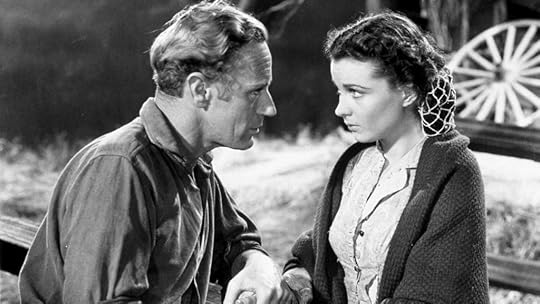 Leslie Howard, actor in Gone with the Wind
Leslie Howard, actor in Gone with the Wind
During the war years you didn’t fly for pleasure or for a two-week holiday in the sun. It was far too dangerous.
Next time we will talk about writing historical fiction for movies.
June 22, 2017
14 – BUYING UP GERMAN ASSETS
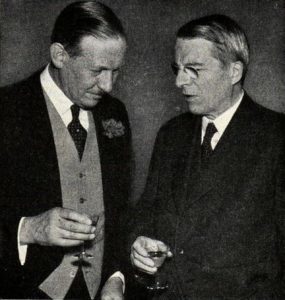 Victor Mallet (left) together with Swedish Foreign Minister Christian Günther, 12 May 1945.
Victor Mallet (left) together with Swedish Foreign Minister Christian Günther, 12 May 1945.It is believed that Sir Victor Mallet of the British Legation in Stockholm was involved in investing funds belonging to the British royal family in German assets. The funds came from the Bank of International Settlements in Switzerland, a secretive bank set up after WWI to deal with reparations. A large amount of money was deposited in an account at the bank in 1937 and use to buy shares in numerous German companies.
Then in 1943 there was a significant transfer of Bosch shares from this bank to the Swedish Enskilda Bank belonging to the Wallenberg family according to Hugh Thomas’ book The Strange Death of Heinrich Himmler. After the war, American treasury agents tried to uncover the dispersal of Bosch shares but were blocked by the British Treasury under pressure from the Foreign Office. Sir Edward Playfair played a key role in obstructing the Americans and said: “The amounts of British capital invested were so great that it made it impossible for a nearly bankrupt Britain to even consider sanctions.”
Another interesting fact is that Allied investigators after the war discovered that numerous Bosch shares were held in a safety deposit box in the name of Karl-Heinz Kramer, Schellenberg’s man in Stockholm.
Another active character in transferring German assets was Allen Dulles, head of OSS, who worked out of his flat in Bern, Switzerland during the war. He had rubber-stamped the transfer of a sizeable portion of Nazi German’s assets by the SS. Working with the Wallenbergs, he had brokered deals with the Swedish firm Bofors to conceal the transfer of German assets.
Recriminations were so bad at the end of the war that the US Treasury were charging the Enskilda Bank and the Wallenbergs of war profiteering. To better cloak the transfer of Nazi assets, the King of England honoured Marcus Wallenberg by making him a Knight of St.Michael and St.George. So the British crown and the British Treasury went out of their way to oppose American proposals to blacklist the Enskilda Bank and the Wallenbergs.
Next time we will talk about commercial flying around Europe during WW2. During the war you didn’t fly for pleasure or for a two-week holiday in the sun. It was far too dangerous and there were no direct flights.
May 22, 2017
13 – SPY CITY
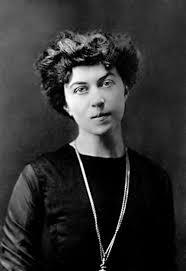 Alexandra Kollontai
Alexandra KollontaiStockholm was a centre of intelligence trading during the war years. The Finns and Estonians were selling Soviet intelligence to the Allies and to the Germans (their allies). The Japanese represented by General Onodera were buying and selling intelligence to their German allies. The Russians were busy trying to force a peace deal on the Finns in 1944 and the Ambassador Alexandra Kollontai was responsible for negotiating a deal. Kollontai was a colleague of Lenin and struggling to maintain her position in the Soviet government as the NKVD closed in on her.
At the end of 1943 the Germans under Reichsführer Heinrich Himmler and Walter Schellenberg RSHA were trying to do a deal for immunity from war crimes prosecution with the Allies in Stockholm.
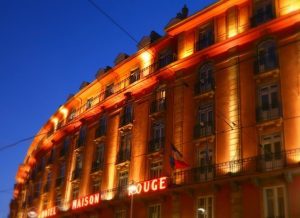 The Maison Rouge Meetings
The Maison Rouge MeetingsIn August 1944 Himmler organized a meeting of selected German industrialists at the Maison Rouge Hotel in Strasbourg. The SS plan was to prepare German industry for the post-war recovery under a new Nazi regime, the Fourth Reich. The German companies would transfer assets abroad and set up a network of secret front companies. Volkswagen, Krupp, Messerschmitt and others were already planning for the post-war period. Many had subsidiaries in Spain, Portugal, and South America. Physical assets like plant machinery were already being moved offshore to avoid damage by Allied bombing.
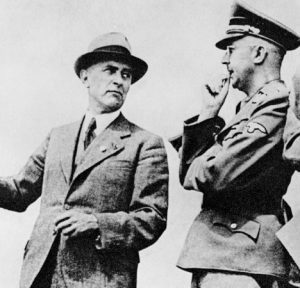 Photograph of Max Faust, an engineer of IG Farben talking to Heinrich Himmler
Photograph of Max Faust, an engineer of IG Farben talking to Heinrich HimmlerThe man in charge was SS Obergruppenführer Dr Scheid who was a senior member of the RSHA. He urged the companies present to make contact and alliances with foreign firms and prepare for the end of the war. This was treasonous talk, but Scheid had a license from the highest level to present the case. He talked about the American partners of Krupp as well as Zeiss, Leica, the Hamburg-America Line shipping company. The plan essentially was to prepare for the Fourth Reich by funnelling cash and assets abroad and buying up foreign companies where these assets could be stored until the war ended through negotiation with the Western powers.
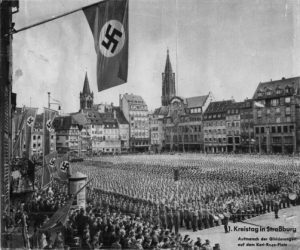 Up until the night of August 10, Strasburg was the safest place in Europe and was regarded as a French city. Churchill had heard about the secret meeting of high-ranking Nazis and decided to bomb the Maison Rouge. The foyer of the hotel had imploded during the night due to the heavy bombardment in the city centre. Jodl, von Ribbentrop and a large number of high-ranking Nazis were rumoured to be staying at the hotel. The following day the management was confronted by a major mystery. It appeared that during the night someone had drilled holes in the doors to the more expensive rooms even when armed SS guards were on guard. These strange perforations were later believed to be the work of the NKVD.
Up until the night of August 10, Strasburg was the safest place in Europe and was regarded as a French city. Churchill had heard about the secret meeting of high-ranking Nazis and decided to bomb the Maison Rouge. The foyer of the hotel had imploded during the night due to the heavy bombardment in the city centre. Jodl, von Ribbentrop and a large number of high-ranking Nazis were rumoured to be staying at the hotel. The following day the management was confronted by a major mystery. It appeared that during the night someone had drilled holes in the doors to the more expensive rooms even when armed SS guards were on guard. These strange perforations were later believed to be the work of the NKVD.
During the Nuremberg trial Soviet intelligence appeared to know everything there was to know about the Maison Rouge meetings and used this information in their interrogation of Harald von Bohlen of the Krupp armaments family whom they had captured in Romania. Another spy, however, was even closer to the event. An agent of the French Deuxième Bureau attended the meetings under the pseudonym of ‘Waddington’ and his report was soon circulating among Allied intelligence agencies.
Next time we will talk about the attempts of the Western nations to buy up German assets at the end of the war.
April 25, 2017
12 – THE WINTER WAR
The Finnish struggle against the Soviet Union figures large in my new novel. It all started during the ‘Winter War” with the Soviet invasion of Finland on November 30, 1939. On December 14, the League of Nations deemed the attack illegal and expelled the Soviet Union from the organization. The Finns put up a vigorous defence of their country against impossible odds. The Soviet Union had three times as many soldiers, thirty times as many aircraft and a hundred times as many tanks, but the Finns forced a military stalemate against incompetent Soviet military officers who couldn’t make a decision in the field without consulting a political commissar.
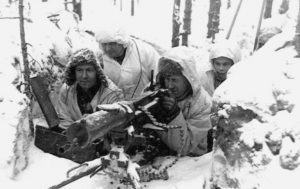 Finnish troops at a machine-gun post during the Winter War.
Finnish troops at a machine-gun post during the Winter War.The Red Army was ill-equipped for a winter war both in regard to clothing and vehicles which couldn’t cope with the cold. The Soviet troops were obliged to fight on a small front since large parts of the border were impassible. The Finns attacked the Russian convoys which were stuck on the roads by using their knowledge of the terrain to get behind the convoys blocking their retreat. So the Soviets had to dig in and were soon attacked from all sides. A major victory for the Finns was the battle for Suomussalmi in the north when the Russians attempted to cut the country in two by striking across country at Oulu.
There was soon an outpouring of support for the Finns across Europe. A Franco-British expeditionary force was organized which would disembark at the Norwegian port of Narvik and proceed by rail toward Finland, passing through the Swedish iron ore fields on the way. This demand was sent to Norway and Sweden on January 6th, but was rejected six days later when Germany threatened to invade Sweden to protect its access to Swedish iron ore.
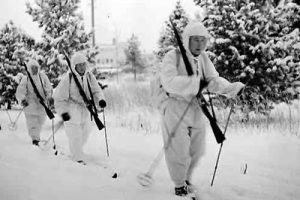 After several months the Russians wore down the Finnish troops with the Soviets only 200 kilometres from Helsinki and a peace treaty was signed in Moscow in March 1940. The Finns were obliged to give up a large swath of land in the Karelian Isthmus including Finland’s second largest city Viipuri and approximately 11% of their territory.
After several months the Russians wore down the Finnish troops with the Soviets only 200 kilometres from Helsinki and a peace treaty was signed in Moscow in March 1940. The Finns were obliged to give up a large swath of land in the Karelian Isthmus including Finland’s second largest city Viipuri and approximately 11% of their territory.
And of course, when Germany attacked the Soviet Union in July 1941, Finland allied itself with Germany and invaded the Soviet Union taking back its lost territory.
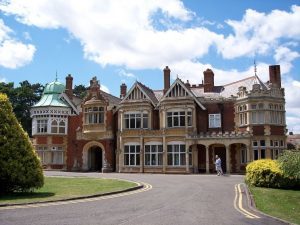 Bletchley Park
Bletchley ParkThe Finns were extraordinary code-breakers and were a good ten years ahead of British code-breaking efforts at Bletchley Park. So Stockholm was a great place for the Finns to sell their services. They broke Soviet military and NKVD cipher codes and were reading American, British, German codes. So it was inevitable that British SIS officer Peter Faye who is the main character in my novel would meet in Stockholm with Colonel Hallamaa of Finnish Radio Intelligence ( RTK).
Please don’t hesitate to leave comments below. Next time we will talk about the Maison Rouge meetings.
April 24, 2017
12 – THE WINTER WAR
The Finnish struggle against the Soviet Union figures large in my new novel. It all started during the ‘Winter War” with the Soviet invasion of Finland on November 30, 1939. On December 14, the League of Nations deemed the attack illegal and expelled the Soviet Union from the organization. The Finns put up a vigorous defence of their country against impossible odds. The Soviet Union had three times as many soldiers, thirty times as many aircraft and a hundred times as many tanks, but the Finns forced a military stalemate against incompetent Soviet military officers who couldn’t make a decision in the field without consulting a political commissar.
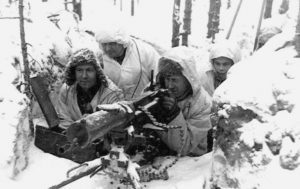 Finnish troops at a machine-gun post during the Winter War.
Finnish troops at a machine-gun post during the Winter War.The Red Army was ill-equipped for a winter war both in regard to clothing and vehicles which couldn’t cope with the cold. The Soviet troops were obliged to fight on a small front since large parts of the border were impassible. The Finns attacked the Russian convoys which were stuck on the roads by using their knowledge of the terrain to get behind the convoys blocking their retreat. So the Soviets had to dig in and were soon attacked from all sides. A major victory for the Finns was the battle for Suomussalmi in the north when the Russians attempted to cut the country in two by striking across country at Oulu.
There was soon an outpouring of support for the Finns across Europe. A Franco-British expeditionary force was organized which would disembark at the Norwegian port of Narvik and proceed by rail toward Finland, passing through the Swedish iron ore fields on the way. This demand was sent to Norway and Sweden on January 6th, but was rejected six days later when Germany threatened to invade Sweden to protect its access to Swedish iron ore.
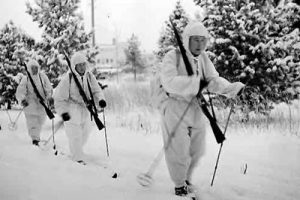 After several months the Russians wore down the Finnish troops with the Soviets only 200 kilometres from Helsinki and a peace treaty was signed in Moscow in March 1940. The Finns were obliged to give up a large swath of land in the Karelian Isthmus including Finland’s second largest city Viipuri and approximately 11% of their territory.
After several months the Russians wore down the Finnish troops with the Soviets only 200 kilometres from Helsinki and a peace treaty was signed in Moscow in March 1940. The Finns were obliged to give up a large swath of land in the Karelian Isthmus including Finland’s second largest city Viipuri and approximately 11% of their territory.
And of course, when Germany attacked the Soviet Union in July 1941, Finland allied itself with Germany and invaded the Soviet Union taking back its lost territory.
The Finns were extraordinary code-breakers and were a good ten years ahead of British code-breaking efforts at Bletchley Park. So Stockholm was a great place for the Finns to sell their services. They broke Soviet military and NKVD cipher codes and were reading American, British, German codes. So it was inevitable that British SIS officer Peter Faye who is the main character in my novel would meet in Stockholm with Colonel Hallamaa of Finnish Radio Intelligence ( RTK).
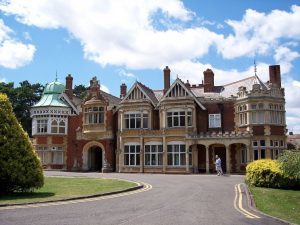 Bletchley Park
Bletchley Park
Please don’t hesitate to leave comments below. Next time we will talk about the Maison Rouge meetings.



